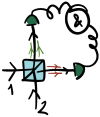Experimental Advances in Phase Estimation with Photonic Quantum States
- PMID: 40724429
- PMCID: PMC12294746
- DOI: 10.3390/e27070712
Experimental Advances in Phase Estimation with Photonic Quantum States
Abstract
Photonic quantum metrology has emerged as a leading platform for quantum-enhanced precision measurements. By taking advantage of quantum resources such as entanglement, quantum metrology enables parameter estimation with sensitivities surpassing classical limits. In this review, we describe the basic tools and recent experimental progress in the determination of an optical phase with a precision that may exceed the shot-noise limit, enabled by the use of nonclassical states of light. We review the state of the art and discuss the challenges and trends in the field.
Keywords: photonic quantum phase estimation; quantum metrology; quantum parameter estimation.
Conflict of interest statement
The authors declare no conflicts of interest.
Figures



References
-
- Abadie J., Abbott B., Abbott R., Abbott T., Abernathy M., Adams C., Adhikari R., Affeldt C., Allen B., Allen G., et al. A gravitational wave observatory operating beyond the quantum shot-noise limit. Nat. Phys. 2011;7:962–965.
-
- Cox G. Optical Imaging Techniques in Cell Biology. CRC Press; Boca Raton, FL, USA: 2006.
-
- Taylor M.A., Bowen W.P. Quantum metrology and its application in biology. Phys. Rep. 2016;615:1–59. doi: 10.1016/j.physrep.2015.12.002. - DOI
-
- Mauranyapin N., Madsen L., Taylor M., Waleed M., Bowen W. Evanescent single-molecule biosensing with quantum-limited precision. Nat. Photonics. 2017;11:477–481. doi: 10.1038/nphoton.2017.99. - DOI
Publication types
LinkOut - more resources
Full Text Sources

